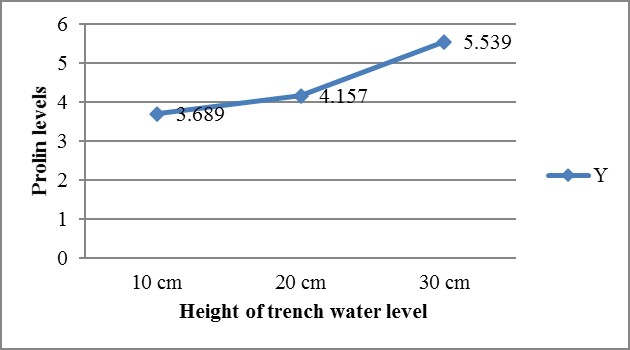Morfo-Physiological Response of Three Shallot Varieties on Water Surface Variation Level
Abstract
The morpho-physiological response study of three shallots varieties on the water surface variation level of the trench aims to find plants that are tolerant of water shortages. The study was conducted in the rice fields of Pulosari village, Brebes District, Brebes Regency, Central Java, Indonesia for three months (January to March 2019). The experimental design used was a separate plot design with three replications. The main plot of trench water surface height (T) is T1 = 10 cm, T2 = 20 cm and T3 = 30 cm. The subplots of shallot variety (V) are V1 = Bima, V2 = Yellow and V3 = Sumenep. The data obtained were analyzed using analysis of variance at 5% error level, if there is a real difference found, the study would be followed by the Least Significant Difference Test (LSD) level 5%. The results showed that the condition of water shortage was very influential on the morpho-physiological response of three shallots varieties.
References
Azmi, C., Hidayat, I. M., & Wiguna, G. (2011). Pengaruh Varietas dan Ukuran Umbi terhadap Produktivitas Bawang Merah. Jurnal Hortikultura. 21(3), 206-213. https://doi.org/10.21082/jhort.v21n3.2011.p206-213
Balai Pengkajian Teknologi Pertanian. (2000). Teknologi Budidaya Bawang Merah. Petunjuk Teknis. Badan Penelitian dan Pengembangan Pertanian. Departemen Pertanian. Ungaran.
Baswarsiati. (2009). Budidaya Bawang Merah dan Penanganan Permasalahannya. Balai Pengkajian Teknologi Pertanian. Jawa Timur. Malang.
Enchalew, B., Gebre, S. L., Rabo, M., Hindaye, B., Kedir, M., & Musa, Y. dan Shafi A. (2016). Effect of Deficit Irrigation on Water Productivity of Onion (Allium cepa L.) Under Drip Irrigation. Irrigation & Drainage Systems Engineering, 5, 172. https://doi.org/10.4172/2168-9768.1000172
Fauziah, R., & Sulistyono, E. dan Susila A. (2016). Budidaya Bawang Merah (Allium ascalonicum L.) pada Lahan Kering Menggunakan Irigasi Sprinkler pada berbagai Volume dan Frekuensi. Journal Hortikultura Indonesia. https://doi.org/10.2944/jhi.7.1.1-8
Gardner, F. P., Pearce, R. B., & dan Mitchel, R. L. (1991). Physiology of Crop Plant. Universitas Indonesia-Press. Jakarta.
Gomes, K. A. & dan Gomes, A. A. (1995). Prosedur Statistik Untuk Penelitian Pertanian. Edisi Kedua. Penerbit Universitas Indonesia (UI-PRESS). Jakarta. 698 hal.
Haryanti, & dan Meirina T. (2009). Optimalisasi Pembukaan Porus Stomata Daun Kedelai (Glycine max (L) merril) Pada Pagi Hari dan Sore. Bioma, 11(1), 18-23.https://doi.org/10.14710/bioma.11.1.11-16.
Hayat, S., Hayat, Q., Alyemeni, M. N., Wani, A. S., Pichtel, J., & Ahmad, A. (2012). Role of Proline Under Changing Environments. Plant Signaling & Bihavior, 7(11), 1-11. https://doi.org/10.4161/psb.21949
Huang, G., Huang, Q., Wang, J., & Pereira, L. S. (2012). Effects of water deficitson growth, yield and water productivity of drip irrigated onion (Allium cepa L.) in an arid region of Northwest China. Irrigation Science, 31, 995-1008. https://doi.org/10.1007/s00271-012-0378-5
Irianto, H., Yakup, U., & Susilawati, S. (2017). Growth and Yield Characteristics of Tree Shallot Varieties Affacted by Phosphate Fertilizer Dosages on Ultisol. Russian Journal of Agricultural and Socio-Economic Sciences, 5(65). https://doi.org/10.18551/rjoas.2017-05.32
Kandil, A. A., Sharief, A. E., Attia, A. N. E., & dan Leilh, A. A. A. (2011). Respons of Onion (Allium cepa L.) Yield to Water Stress and Mineral Biofertilization. Acta Agronomica Hungaria, 54(4), 361-370. https://doi.org/10.1556/AAgr.59.2011.4.7
Kurniawati, S., Khumaida, N., Ardie, S. W., Hartati, N. S., & dan Sudarmonowati, E. (2014). Pola Akumulasi Prolin dan Poliamin Beberapa Aksesi Tanaman Terung Pada Cekaman Kekeringan. Journal Agronomi Indonesia, 42(2), 136-141. https://doi.org/10.24831/jai.v4212.8432
Lakitan, B. (2012). Dasar Dasar Fisiologi Tumbuhan. PT. Raja Grafindo Persada. Jakarta.
Marpaung, A. E., & dan Rosliani, R. (2019). Adaptability of Growth and Yield on 5 Varieties of Shallot (Allium ascalonicum L.) in Wet Highland. Journal of Tropical Horticulture, 2(1). https://doi.org/10.33089/jthort.v2i1.12
Mubarak, I., & Hamdan, A. (2018). Onion Crop Respons to Regulated Deficit Irrigation Under Mulching in Dry Mediterranean Region. Journal of Horticultural Research, 26(1), 87-94. https://doi.org/10.2478/johr-2018-0010
Muhamad, D. (2010). Pengaruh Cekaman Kekeringan Terhadap Pertumbuhan dan Beberapa Karakter Morfo-Fisiologi Tanaman Nilam. Buletin Penelitian Tanaman Rempah dan Obat(BUL LITTRO). 21(1), 8-17. Balai Penelitian Tanaman Obat dan Aromatik. Bogor.
Mutetwa, M., & dan Mtaita, T. (2014). Effect of Mulching and Fertilizer Sources on Growth and Yield of Onion. Journal Global Innovation in Agricultural Social Sciences (JGIASS), 2(3), 102-106. https://doi.org/10.17957/JGIASS/2.3.561
Nandle, N., Sharma, R. K., Kushwah, S. S., & Gallani, R. (2018). Effect of Irrigation Regims and Varietas on Growth, Bulb Yieldand Quality of Onion (Allium cepa L.). International Journal of Curren Microbiology and Applied Science, 7(5). https://doi.org/10.20546/ijcmas.2018.705.135
Nugraheni, W. (2010). Variasi Pertumbuhan, Kandungan Prolin dan Aktivitas Nitrat Reduktase Tanaman Ganyong (Canna edulis Ker.) Pada Ketersediaan Air Yang Berbeda. Thesis. Universitas Negeri Surakarta. Surakarta.
Patel, N., & Rajput, T.B.S. (2013). Effect of Deficit Irrigation on Crop Growth, Yield and Quality of Onion in Subsurface Drip Irrigation. International Journal of Plant Production, 7(3), 417-426. https://doi.org/10.22069/ijpp.2013.1112
Rosawanti, P. (2016). Pengaruh Cekaman Kekeringan Terhadap Kandungan Klorofil danProlin Daun Kedelai. Anterior Journal, 15(2). https://doi.org/10.33084/anterior.v15i2.52
Saidi, A. (2006). Fisika Tanah dan Lingkungan. Andalas University Press. Padang.
Salisbury, F. B., & dan Ross, C. W. (1995). Fisiologi Tumbuhan. Institut Teknologi Bandung. Edisi Keempat. PenerbitInstitut Teknologi Bandung. Bandung.
Sumarni, N., & dan Hidayat, A. (2005). Panduan Teknis. Budidaya Bawang Merah. Balai Penelitian Tanaman Sayuran. Pusat Penelitian dan Pengembangan Hortikultura. Badan Penelitian dan Pengembangan Pertanian. Lembang Bandung.
Suwandi, & dan Hilman, Y. (1995). Budidaya Tanaman Bawang Merah. Teknologi Produksi Bawang Merah. Pusat Penelitian dan Pengembangan Hortikultura. Badan Penelitian dan Pengembangan Pertanian. Jakarta.
Swasono, F. D. H. (2012). Peran ABA dan Prolina dalam Mekanisme Adaptasi Tanaman Bawang Merah Terhadap Cekaman Kekeringan di Tanah Pasir Pantai. Journal Agrisains, 4(5), 71-78. ISSN: 2541-5069.


This work is licensed under a Creative Commons Attribution 4.0 International License.
Copyright for this article is retained by the author(s), with first publication rights granted to the journal.
This is an open-access article distributed under the terms and conditions of the Creative Commons Attribution license (http://creativecommons.org/licenses/by/4.0/).








1.png)














